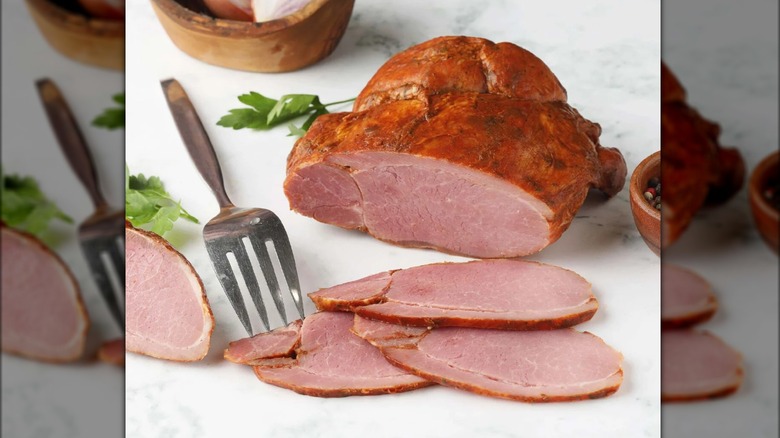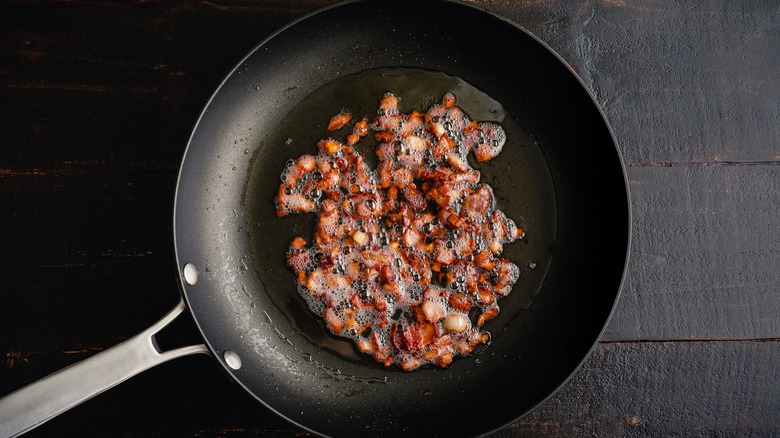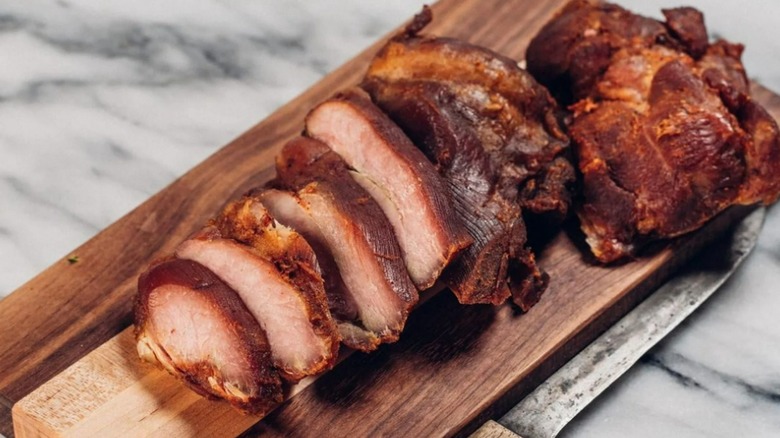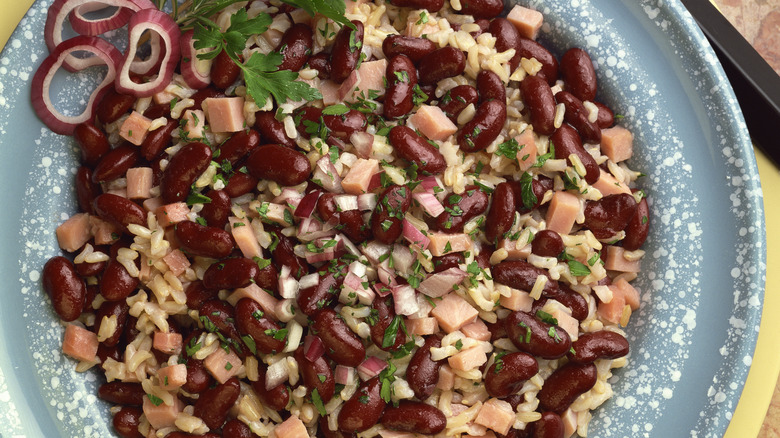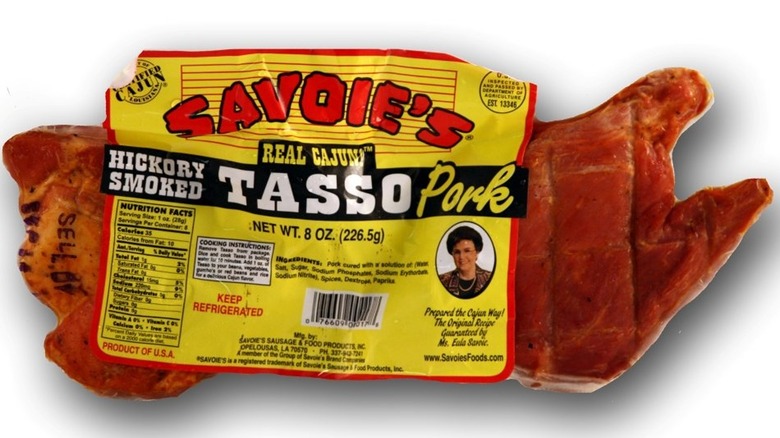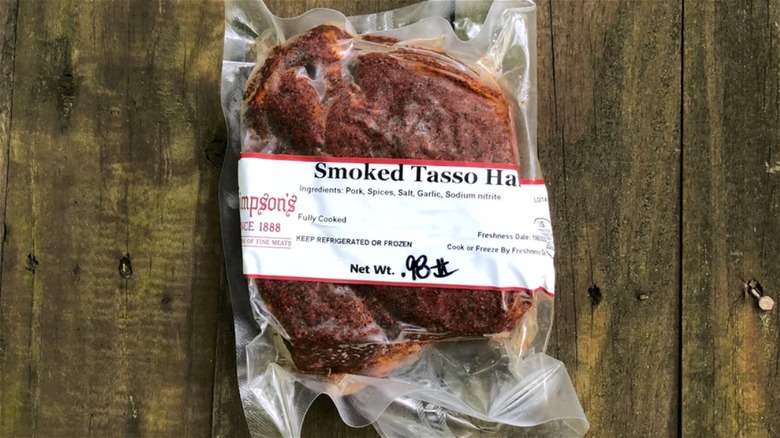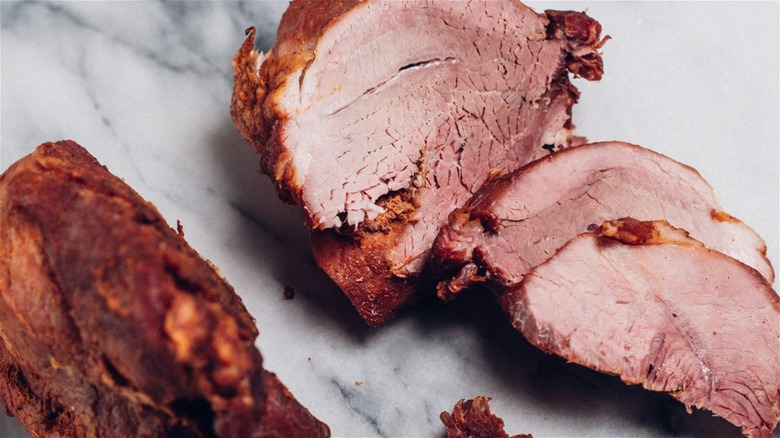Tasso Is The Smoky And Spicy Ham That You Need To Start Cooking With
We may receive a commission on purchases made from links.
The cuisine of Louisiana encompasses everything that makes American food so unique, resulting from an impressive amalgamation of various cultures from around the globe that combine to give this food its trademark originality. Fresh seafood from the gulf — along with the sacred mirepoix known as the holy trinity — is cooked into spicy stews to act as the bread and butter of this cuisine. Cajun and Creole dishes like gumbo and étouffée are known throughout the world as some of the most distinct and delicious dishes to come from the region. Admittedly, Louisiana's heavy focus on seafood means that other lesser-known dishes and ingredients wind up on the back burner, so to speak, in terms of worldwide notoriety.
Those outside of Louisiana usually think of seafood and spicy seasoning when they think of Cajun fare, but those born and raised in the bayou know that there exists a myriad of eclectic ingredients that this cuisine thrives on. Tasso — a flavorful pork product — aids in Louisiana's reputation for producing zesty dishes, and of all the ingredients essential in Cajun cuisine, few are as versatile and necessary as this ubiquitous ingredient. I interviewed chef Stephen Stryjewski — James Beard Foundation Award winner and co-owner of Cochon Butcher in New Orleans — to discover what makes tasso so crucial in Cajun cooking.
What is tasso?
Tasso is a spicy, smoky ham of Louisiana origins famous for its role in traditional Cajun dishes. Classic stews like gumbo and éttouffée and hearty dishes like jambalaya and dirty rice are all enhanced by the flavor and savory richness of tasso. Although it isn't a necessary ingredient in these dishes, tasso bolsters the flavor and texture of traditional Cajun rice-based and stew-like meals, bringing them back to their rustic, spicy roots.
Tasso's name comes from the Spanish tasajo, meaning cured or dried meat. Although tasso's origins have never been precisely documented, the earliest references to tasso come from the mid 1700s, when the spiced cured meat we know today was made from buffalo and known as "tassagear" in American French settlements.
"Tasso is a cured and smoked pork product typically used for seasoning," says Chef Stephen Stryjewski. It's made from pork shoulder, which is ideal for use in stews and other slow-cooked recipes. Soups and stews — usually involving beans, greens, or seafood — are exactly where tasso gets to shine in the world of Cajun fare. Pork shoulder typically needs to cook low and slow for it to reach maximum tenderness, so tasso is right at home in dishes like catfish courtbouillon — an old-fashioned, fishy Cajun stew — and éttouffée.
How is tasso different from regular ham?
Compared to the common types of ham frequently found at a deli — such as country ham or city ham — tasso is much more flavorful. Although tasso starts out as something similar to a city ham, according to Chef Stephen Stryjewski, once it's packed with spices and smoked, then it can be considered tasso. Most styles of ham get their flavor from their marbling or particular cooking methods used in their preparation; tasso gets its flavor from the techniques at work — brining and smoking — but much of its flavor comes from the spices that Louisiana's cuisine is so famous for. These spices — including cayenne, garlic, oregano, black and white pepper, and sugar — combine to form a spicy, earthy, sweet, herbaceous, and all-around nuanced and bold world-famous flavor profile.
Although it's sometimes referred to as "Cajun ham," technically, tasso isn't actually ham. Ham typically comes from the back leg of the pig and not the shoulder. Generally, ham winds up as the star of the show in a meal, but tasso's role is much more subtle. The seasoned and cured ham is concentrated with spice and is then used to season dishes. So think of tasso like a heartier, juicier version of Cajun seasoning.
Chef Stryjewski explains that tasso is brined and cured and then packed with traditional Cajun seasoning before it's smoked. It's usually left to air-dry, where the spices form a crusty, crunchy layer on the outside of the meat. While it's drying, the salt and Cajun spices work their way into the meat and create an explosion of flavor while helping to keep the meat fresh for longer.
What does tasso taste like?
On its own, tasso offers a burst of Cajun flavor carried by the rich, meaty taste of high-quality smoked ham. Cajun seasoning gives tasso its zestiness, making it the ideal meat choice to accompany beans, seafood, or veggies in soups and stews, accentuating the mild flavor of these traditional Southern ingredients. Since tasso is imbued with Cajun spices, its flavor becomes embedded in a dish more so than if those same spices were just sprinkled in. Tasso is a popular spice alternative for this reason, giving Southern dishes the depth of flavor and oleaginous texture that they're known for.
"Tasso is typically drier than a regular smoked ham," says Chef Stephen Stryjewski. "It is usually on the lean side. The spice mixture is a Cajun mix with lots of chili, cayenne, paprika, garlic, and thyme." Chef Stryjewski notes that the tasso is both smoky and spicy, but both flavors are mild enough to blend seamlessly into most dishes without overpowering them. Before tasso is smoked, the fat cap is removed from the pork shoulder, resulting in leaner meat with little marbling. This lack of fat gives the ham that tasso is made from a more neutral flavor, making it an ideal blank canvas for Cajun seasoning to shine on. Since tasso is designed to add flavor to meals, it's usually quite salty, so it's not recommended to grab a fork and knife and go to town on a big hunk of this brined meat.
How do you cook with tasso?
You wouldn't make a sandwich for lunch with sliced tasso or serve it for Christmas dinner. Tasso plays a very specific part in Cajun cuisine and culture. The spices that it's packed in are developed with traditional Cajun fare in mind, although tasso can find a home in any flavorful stew-like dish that's intended to be on the spicier side. Although tasso usually plays a specific role, it can be a savory, versatile ingredient if you're willing to get creative.
Old-fashioned seafood stews, like gumbo, come to life when made with tasso, and jambalaya receives a boost in heat and sweet and savory flavors when made with umami-packed meat. Isaac Toupe's rouxed peas and tasso recipe allows the ham to shine front and center, while in most recipes, it's doing most of the flavor heavy-lifting in the background.
"Traditionally, tasso is used as a seasoning meat. It is almost [always] required in most slow-cooked bean preparations," explains Chef Stephen Stryjewski. "Red beans or white beans both love the smoke and spice that tasso adds. Greens also match well with tasso. The long cooking breaks down the meat and the spice brightens up the dish." Certain recipes require tasso to be diced and cooked in a skillet until brown, similarly to how one would cook bacon for a carbonara. Then other ingredients are cooked in the sizzling fat from the tasso, imparting smokiness and seasoning throughout the cooking process for a bright burst of spicy flavor in every bite.
Tasso nutritional information
Tasso's nutritional information can vary depending on whether you purchase it at the grocery store, from your local butcher, or if you prepare it from scratch at home. Generally, a 2-ounce serving of tasso ham contains around 130 calories, 9 grams of fat, and 3 grams of saturated fat, which makes up about 15% of a daily allotment of saturated fat, based on an average 2,000 calorie diet. A 2-ounce serving of tasso also contains 10 grams of protein and 420 milligrams of sodium, or 18% of the daily value of sodium.
Like most brined meats, tasso is high in protein, but also high in sodium and should be consumed in moderation. Since tasso is typically used in relatively small amounts to flavor dishes, its sodium content isn't too worrisome. When cooking with tasso, be sure to keep its high levels of salt in mind and don't add too much extra salt to the dish. Oversalting a dish can ruin its flavor and, if done too often, can result in health complications. While oversalting can be fixable, it can easily double the time it takes to prepare a meal.
Where to buy tasso
Tasso is hard to come by at stores and butcher shops outside of Louisiana, but in the Bayou State, tasso is abundant. You can sometimes find tasso outside of Louisiana at large retailers like Whole Foods, Walmart, or Texas-based H.E.B. But if you live outside of Louisiana, your best bet is to purchase tasso online from retailers like Cajun Grocer, where you'll even find Cochon Butcher's own house-made tasso. The tasso will arrive at your house packed in dry ice, so it's ready to store in the fridge or freezer as soon as it arrives.
In Louisiana, you'll find tasso at most small grocery stores, butcher shops, large chains, and maybe even a gas station way out in the country. I'd recommend opting for tasso from your favorite butcher, like chef Stephen Stryjewski's butcher shop and restaurant Cochon Butcher in New Orleans. At a butcher shop, you'll always receive the freshest possible meats prepared by skilled butchers who know the meat inside and out. At Cochon Butcher, you can purchase tasso ham by the pound or enjoy it in one of the restaurant's many meat-centric dishes.
Are there different varieties of tasso?
Different brands of tasso offer different flavor profiles, and most Louisiana residents have their go-to tasso that they rarely stray away from. "Savoie's tasso is light on the spice," says Chef Stephen Stryjewski, "[and] Paul Purdhomme's product is what I base my original recipe on. I liked the spice level and subtle smoke." Chef Stryjewski explains that the cushion meat — a lean, deboned cut from the outside area of the shoulder — is used to make Cochon Butcher's tasso, but any lean pork can be used for your homemade recipe. He says that one of the reasons that tasso tends to be lean is to preserve the meat. The fat in meat is structured irregularly, and although this has biological advantages when the animal is alive, this renders the meat more susceptible to oxygen-fueled attacks, which causes it to spoil. Tasso's lack of fat means it stays fresh longer, so you can leave your tasso in the fridge and make multiple meals with the same cut.
While most tasso is quite similar in preparation and flavor, tasso is popular enough that some more unique varieties can be found. For example, turkey tasso is an ideal swap for traditional tasso in most recipes. This turkey ham is made with boneless turkey thigh meat and is prepared in the same way as traditional tasso. While turkey tasso isn't nearly as popular as regular tasso, it's a great choice for those who don't eat pork for religious or health reasons or for those looking for an even leaner meat choice for their Cajun recipes.
How do you store tasso?
Tasso ham can be stored in the refrigerator or freezer, depending on when you plan to use it. Chef Stephen Stryjewski says that he prefers to store his tasso in the freezer. He explains that store-bought tasso typically keeps in the refrigerator for three to four weeks but will stay fresh in the freezer for multiple months. Stryjewski says that the tasso from Cochon Butcher or your favorite homemade recipe doesn't last quite as long as store-bought tasso; usually two weeks in the fridge and about one month to six weeks in the freezer.
If you're planning to prepare your own homemade tasso, aim to store it in the freezer no more than three days after it's been prepared so that it retains its proper texture, flavor, and freshness. If you remove your tasso from the freezer and then attempt to refreeze the ham, be prepared for a slightly less tender, drier texture. Since tasso is already on the dry side, and since it's typically only used to season dishes, this probably won't make much of a difference. As long as you keep your tasso at a safe temperature when it's thawed, you can refreeze it without having to worry about the risk of foodborne illness.

